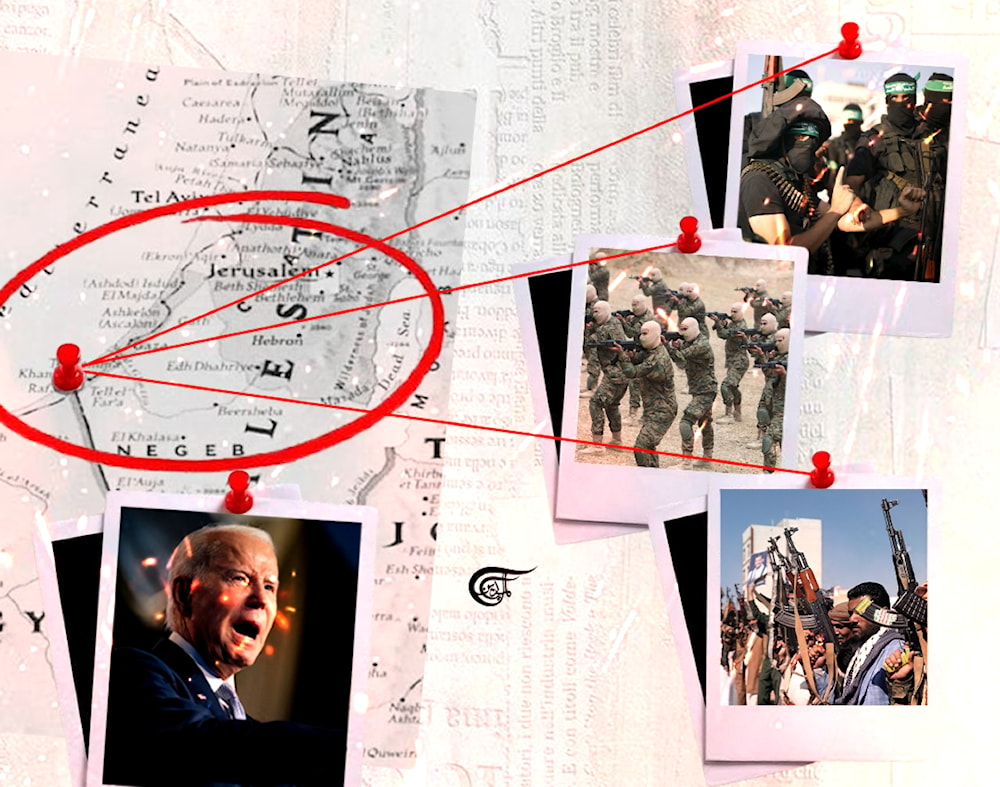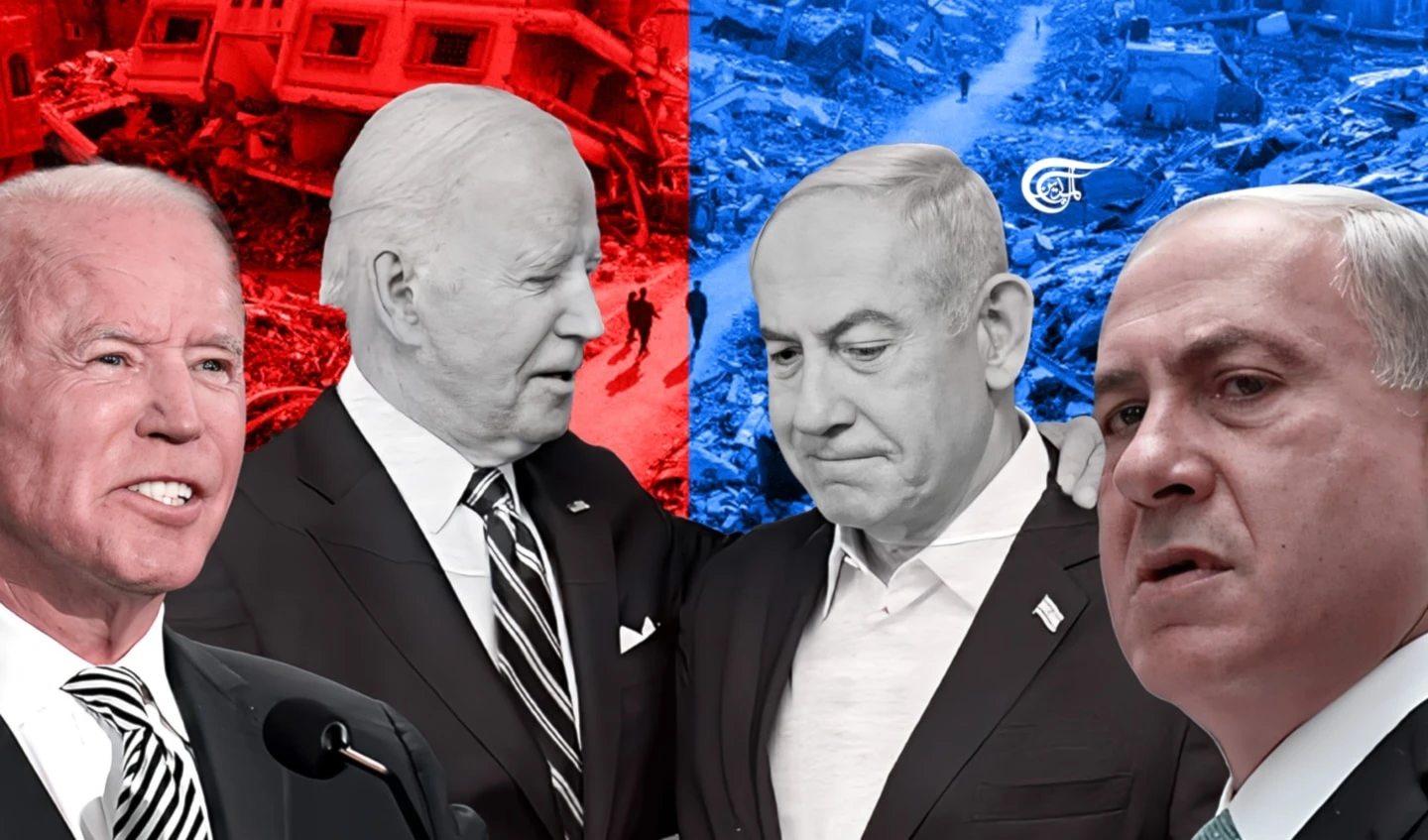Biden’s war on Gaza: An attempt to close the window of Resistance in Palestine
What is "Israel" planning for the Axis of Resistance, both in Gaza and beyond, should it be successful in conquering the enclave?
-

Politically, any manifestation of sovereignty, whether in public life or on the battlefield, is an expression of presence and attendance for the sake of completing the national liberation project. (Al Mayadeen English; Illustrated by Batoul Chamas)
American and international pressures forced the Palestine Liberation Organization (PLO) in 1998 to abandon the principle of armed struggle and remove it from its charter, in exchange for a promise to establish a political entity under which the Palestinians would be granted a “state” on what remained of the lands of the West Bank and Gaza Strip. This was after the supposed area of this state had shrunk after the 1967 Naksa (literally “setback”).
This is called the "two-state solution.". The rejection of this solution by the absolute majority of the Zionist Knesset, 99 votes out of 120, at the end of February 2024, was not a reaction to the Operation Al-Aqsa Flood, which inflicted a terrible defeat on the occupying entity. The occupation leaders’ rejection of the solution approved by the Security Council many decades ago is based on their practice of deception, seizing lands, launching military attacks, and establishing settlements to change the status quo, until the area of the desired Palestinian state had shrunk from 42.3 to the current 22 percent of the lands of historic Palestine.
The concept of the “two-state solution” may not apply today to what was specified at the time, and certainly not its frameworks agreed upon in the multiple negotiations that took place between the Palestinians and the Zionists. The two-state solution has become hostage to a set of American conditions expressed by US President Joe Biden who is aiming for “a more durable peace and security for Israel, fully integrated within the region, and a two-state solution with Israel's security guaranteed."
We can try to find out the reasons for the Zionist rejection of the “Palestinian state,” based on the occupying entity’s fear that this state will one day, at a regional or international moment, become a true rival to the entity, militarily, culturally, and socially. This becomes more poignant with the emergence of a sovereign model in the Gaza Strip, such as the Hamas movement’s rule, which is working on a liberation project for the entire Palestinian territories with external support, especially with fundamentals that this supposed state possesses, the first of which is the presence of an authentic Palestinian population which traces and history in every town and village of the land of Palestine, supported by a rapid demographic increase that makes “Palestinian society young and more than a third of its population is under the age of 15.” The second is the long and extensive experience in political and military action against the Zionists, and it has external connections with the Axis of Resistance. The third, and most important, is the awareness of this country’s people that the “neighboring country” is nothing but the gang that expelled it from its land and killed and displaced its members in parts of the world.
This background perception among the Zionists of what a Palestinian state represents and a direct American pledge to the decision to end the Hamas movement in the Gaza Strip led to a massacre against the Palestinian people amounting to genocide of the Palestinians, in which “Israel” denied them food, medicine, and survival supplies. Firstly, because “forced displacement along with genocide are the pillars of the Zionist mind and settler colonialism,” and secondly, because of the political discrepancy between the American administration’s acceptance of the two-state solution and the Zionists’ absolute rejection of this solution. Here the question arises: The military operation continues despite its insignificant success, and the political solution, called the two-state solution, is unacceptable to the Zionists. So why does the war continue?
The current war has another American side, the opportunity for which arose after Operation Al-Aqsa Flood, when the US tried to end the Hamas movement and restrict its presence in the Gaza Strip. This means weakening and paralyzing one of the Axis of Resistance’s parties inside Palestine, which considers itself obligated to perform its legal, religious, and moral duty toward a section of the Palestinian people in resisting the occupation of Palestine.
Islamic and Arab nations are calling upon Hamas to restore its rights and its usurped land. Successfully targeting Hamas reduces the margin of maneuvering available in the Gaza Strip and disables one of the arenas that the Axis of Resistance works to support, which is considered the main axis of its liberation work from the Zionist occupation and Western hegemony. Therefore, the US considers that its current battle against the Gaza Strip, in response to a decision made personally by the US President[9], is to close the margin of maneuver in the Strip once and for all against the military or political intervention of the Axis of Resistance. “Our goal should not be simply to stop the war for today; it should be to end the war forever, break the cycle of unceasing violence, and build something stronger in Gaza and across the Middle East so that history does not keep repeating itself,” according to the words of President Biden, who explains, in a letter published by Newsweek, his vision for a solution centered on a renewed Palestinian authority in Gaza Strip that replaces Hamas and the West Bank. This renewed authority would provide security for the occupying entity.
He says: “Gaza must never again be used as a platform for terrorism… Gaza and the West Bank should be reunited under a single governance structure, ultimately under a revitalized Palestinian Authority, as we all work towards a two-state solution.”
Defeating Hamas politically and militarily
There is no doubt that defeating Hamas in the traditional way in Gaza, meaning removing any manifestation of its sovereignty and imposing force and law, even at the level of municipal work, and preventing any activity that could mean the beginning of the movement’s return to Gaza, is the desired goal of the Zionists and Americans, and it is a problem that is extremely important due to its internal and external complexities, because any alternative form of sovereignty needs palatable components for the Gazan public in order to replace the movement.
Politically, any manifestation of sovereignty, whether in public life or on the battlefield, is an expression of presence and attendance for the sake of completing the national liberation project. Meanwhile, the goal of the Zionist aggression, regardless of its success in doing so, is to eliminate any presence of Hamas in the Gaza Strip, militarily or otherwise. The military operation aims to eliminate Hamas physically, if possible, or inflict a huge human and logistical cost on its ranks that forces it to submit and surrender.
As they consider the hypothesis of the victory Zionist enemy over the Hamas movement and the breaking of its military power, the Zionists will consolidate this achievement, maximize its repercussions, and complete what can be considered an extension of this military victory on other fronts, perhaps on the Lebanese or Syrian borders, or those geographically distant from its entity, such as Yemen or Iraq. The question here is, what is the expected direct action of the enemy towards the parties on the Axis of Resistance?
Disengagement between the West Bank and Gaza Strip
The Zionists inside occupied Palestine will exploit the defeat of Hamas to complete everything that would Judaize Al-Quds, separate the West Bank from settlements, impose more obstacles to the presence of Jerusalemites and the rest of the Palestinian population, up to the point of displacing them from the West Bank to Jordan, and tighten final security and political control over the West Bank.
It goes without saying that Zionists know that Hamas, the Islamic Jihad, and the rest of the factions are working to transfer the expertise and experience of the resistance in Gaza to the West Bank, in order to enable them to respond to racist Zionist practices, and to the desecration to which Al-Aqsa Mosque is being subjected under the auspices of the Zionist police, the excavation operations under the mosque, the settlers’ attacks on the Palestinians and their livelihoods, uprooting olive trees, confiscating lands, demolishing homes, assaulting women, and arresting men including the young; and to support prisoners in the occupation prisons who are subjected to abuse by the Zionist authorities. Zionist politicians and Israeli media have long warned of the popular and military explosions in the West Bank as a result of the Zionist attacks against the Palestinians.
The Resistance has succeeded in connecting the West Bank with the Gaza Strip, which was most evident in the battle of Seif Al-Quds (10/5/2021) following the settlers’ raids on Al-Aqsa Mosque and the Israeli plans to deport the residents of the Sheikh Jarrah neighborhood in Al-Quds under the Resistance’s threats, and its targeting of the Zionist depth with missiles. Since that battle, interaction and solidarity have automatically occurred with any military or security development there, but the defeat of Hamas in the Gaza Strip will give the occupation army the ability to liquidate Resistance enclaves in the West Bank and strike with an iron fist without fear of a significant reaction from the Strip.
Priority of targeting Lebanon and Yemen
Externally, when the situation stabilizes and the battles end, and in cooperation with the United States of America, “Israel” will study the position on the external threats that accompanied its aggression against the Gaza Strip, from Lebanon particularly, with the aim of finding a way to break the siege imposed by the Axis of Resistance, particularly the Lebanese Islamic Resistance, which was the most severe on the entity and targeted the entire Zionist military presence in the northern occupied Palestinian region, aiming to distract as many of its divisions and brigades as possible from participating in the aggression against the Gaza Strip.
Zionist strategists will study and develop a plan to nullify the effectiveness of the coordination of the Axis of Resistance and separate the arenas from each other. The largest share of these plans will focus on Lebanon, due to its existential threat to the occupying entity, owing to the presence of the Lebanese Islamic Resistance there, whose military participation was characterized by great effectiveness and revealed to the public key weapons in its possession, such as anti-aircraft weapons. There are also other reasons that require the Zionists to accelerate plans to target Lebanon, such as the maritime competition over oil and gas fields, and their deliberate intention to take revenge for inflicting successive defeats on them, the largest of which were in 2000 and 2006.
Yemen’s Military Participation
Yemen's recent participation in the activities of the Axis of Resistance and it joining the Unity of the Battlefields is of special importance. It represents a huge shift in a very sensitive geographical area, represented by the State of Yemen taking political decisions that affect the global environment and contradict what the American administration and Western governments desire to protect their interests and those of the occupying entity in Palestine.
This takes us a little back, to the beginning of the 1950s, when the Zionist navigational presence began appearing from the Red Sea to the Gulf of Aqaba, ending at the port of Umm al-Rashrash (Eilat), with talk of the necessity of crossing the Strait of Tiran and Sanafir off the Egyptian Sharm El-Sheikh in Sinai.
The Zionists had succeeded in dealing with the issue of the islands of Tiran and Sanafir, making them demilitarized zones in the “Peace Treaty” with Egypt in 1979, and allowing Zionist navigation through them without obstacles, after they were the cause of the outbreak of the 1967 war after they were closed to Israeli navigation by decision of Egyptian President Gamal Abdel Nasser.
Egypt had issued laws, according to which it worked to inspect ships heading to the occupying entity through the Strait of Tiran, because it was at war with it. The second paragraph of Article Five of the “Peace Treaty” of 1979 stipulated that “the two parties consider the Strait of Tiran and the Gulf of Aqaba to be international waterways, open to all countries without hindrance or interruption to freedom of navigation or air transit. The two parties also respect each other’s right to navigation and air transit in order to reach their territories through the Strait of Tiran and the Gulf of Aqaba.”
The current state of Israeli navigation in the Red Sea is similar to that period’s, as the Yemeni army and Ansar Allah forbade Israeli ships from crossing the Red Sea to and from “Israel” in support of Gaza and the Palestinian people. This was done for the same political reasons that drive the West to support the occupying entity and provide it with all kinds of military, economic, and financial support to massacre the Palestinian people. It should be noted that the Zionist conspiracy against Yemen has been ongoing since the occupation entity meddled in the Yemeni civil war in the 1960s by arming Imam Badr’s supporters against Abdel Nasser, and even after, when the American-Saudi aggression coalition, under the pretext of Decisive Storm in 2015. Yemen, due to the Zionists, is being exposed today to an ongoing US-British-Western aggression, with air and naval bombardment in defense of the occupying entity.
Like the implicit position of some Arab countries, the occupying entity prefers that Yemen remain a divided, weak country in need of international care, which makes it lose some of its sovereign decisions and attracts the ambitions of others. While the independent decision of Yemen today, under the leadership of Sayyed Abdul Malik Badr al-Din al-Houthi, has enabled an Arab force to confront superpowers, impose their conditions on them, and target Zionist ships and those who assist them, whether militarily or commercially. This is a development that the United States, the occupying entity, or the West in general did not expect for a new force to rule to turn the tide, support the Axis of Resistance, and possess the latest advanced weapons in the maritime field. This is combined with an unprecedented state of popular mobilization inside Yemen, military training, and human volunteering to form a fighting force with the aim of field participation against the Zionists on the occupied land of Palestine. It is a revolutionary model that can be exported to other countries and incite their people to participate in fighting the occupation entity.
Therefore, the occupying entity aspires to return Yemen to the time before Ansar Allah came to power in 2014, and remove this obstacle to completing the integration of the entity into the Arab and Islamic environment through economic exchanges and the Abraham Accords. It is also ready, if it is victorious in its current battle against the Hamas movement, to engage in security and military actions against Yemen that would restore to it some of its lost prestige after the Yemeni army’s targeting of its ships in the Red Sea and its bombing of Eilat and other areas inside occupied Palestine, knowing that its preparations in the Red Sea have not stopped since before the Al-Aqsa Flood and since Ansar Allah assumed power; whereas: “There is joint Israeli-Emirati action in Yemen to establish military bases and joint areas of influence, especially with the spread of American bases in the Gulf region, and Israeli coordination with the American army will make it capable of carrying out any military action, if it wants.”
In addition, the occupying entity considers itself a member of the international coalition that has entrusted itself with protecting the shipping lanes in the Persian Gulf and the Red Sea since before the Al-Aqsa Flood operation, where, according to the military analyst for the Yedioth Ahronoth newspaper, Ron Ben-Yishai, “the most important and most prominent Israeli contribution is related to participating in the security and safety of sea trips in Bab al-Mandab, where the Houthis threaten Arab oil tankers belonging to Saudi Arabia, the Emirates, and Kuwait, which transport oil to Europe via the Red Sea and the Suez Canal.”
Accordingly, it can be concluded that the American and the Western approach to besieging Ansar Allah in Yemen and preventing them from seizing the Bab al-Mandab Strait and imposing Yemeni sovereignty over it will be developed by available military and political means, by intensifying the presence of naval warships that confront the Yemeni military action at sea, which is already happening, to reach a stage in which the strategic stock of ballistic missiles, cruise missiles, and air strikes of Ansar Allah and the Yemeni army would have decreased significantly.
Furthermore, the approach is intended to obstruct the peace plans that the Yemenis reached with Saudi Arabia to stop the war and restore normal pre-Decisive Storm relations. It will also exhibit firmness by tightening the economic and political blockade, and perhaps launching a military campaign against Sanaa with the aim of removing Ansar Allah’s rule. Working in these directions and focusing on the closest ones will be a success for the goal of protecting Zionist navigation in Bab al-Mandeb, and increasing the participation of Ansar Allah in the Axis of Resistance, regardless of the result of the collapse of the Hamas movement in Gaza or its steadfastness.

 Nasser Al Housseini
Nasser Al Housseini
 16 Min Read
16 Min Read









